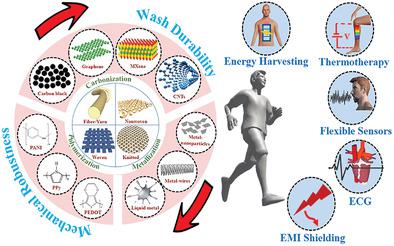当前位置:
X-MOL 学术
›
Adv. Electron. Mater.
›
论文详情
Our official English website, www.x-mol.net, welcomes your
feedback! (Note: you will need to create a separate account there.)
Mapping the Progress in Flexible Electrodes for Wearable Electronic Textiles: Materials, Durability, and Applications
Advanced Electronic Materials ( IF 5.3 ) Pub Date : 2021-09-03 , DOI: 10.1002/aelm.202100578 Md Luthfar Rahman Liman, M. Tauhidul Islam, Md Milon Hossain
Advanced Electronic Materials ( IF 5.3 ) Pub Date : 2021-09-03 , DOI: 10.1002/aelm.202100578 Md Luthfar Rahman Liman, M. Tauhidul Islam, Md Milon Hossain

|
With the advancement of nanotechnology and electroactive materials, conventional textiles have transformed into a versatile wearable electronic platform that will inevitably escalate the development of next-generation flexible electronics. Integration of nanoscale conductive particles such as polymers, metals, or nanocarbons into different structural textile design has simplified the way of personal interactive communications and portable sensing by distributing superior stretchability and functionality in a smart textile device. However, for the real-life application, it is crucial to recognize the functional reliability of wearable textile electronics. This review comprehensively summarizes the recent progress in electronic textiles (e-textiles) using different electroactive materials and textile architectures for numerous wearable applications. The first section highlights different textile architectures used in e-textiles and their various properties. Various electroactive polymers from carbon, metal, and conductive polymers, including their electromechanical properties and wash durability, are then discussed. Subsequently, progress in textile-based energy harvesting and storage, personal thermal management, flexible sensing, electrocardiography (ECG), electromagnetic interference shielding are presented. Finally, the remaining challenges regarding the current materials and processing strategies are pointed out, and practical strategies to fully realize e-textile systems are suggested.
中文翻译:

绘制可穿戴电子纺织品柔性电极的进展:材料、耐用性和应用
随着纳米技术和电活性材料的进步,传统纺织品已经转变为多功能的可穿戴电子平台,这将不可避免地推动下一代柔性电子产品的发展。将聚合物、金属或纳米碳等纳米级导电颗粒集成到不同结构的纺织品设计中,通过在智能纺织品设备中分配卓越的拉伸性和功能,简化了个人交互通信和便携式传感的方式。然而,对于现实生活中的应用,认识到可穿戴纺织电子产品的功能可靠性至关重要。这篇综述全面总结了电子纺织品(e-textiles)在众多可穿戴应用中使用不同电活性材料和纺织品架构的最新进展。第一部分重点介绍了电子纺织品中使用的不同纺织品结构及其各种特性。然后讨论了来自碳、金属和导电聚合物的各种电活性聚合物,包括它们的机电性能和耐洗性。随后,介绍了基于纺织品的能量收集和存储、个人热管理、柔性传感、心电图 (ECG)、电磁干扰屏蔽方面的进展。最后,指出了当前材料和加工策略的剩余挑战,并提出了全面实现电子纺织系统的实用策略。然后讨论它们的机电性能和耐洗性。随后,介绍了基于纺织品的能量收集和存储、个人热管理、柔性传感、心电图 (ECG)、电磁干扰屏蔽方面的进展。最后,指出了当前材料和加工策略的剩余挑战,并提出了全面实现电子纺织系统的实用策略。然后讨论它们的机电性能和耐洗性。随后,介绍了基于纺织品的能量收集和存储、个人热管理、柔性传感、心电图 (ECG)、电磁干扰屏蔽方面的进展。最后,指出了当前材料和加工策略的剩余挑战,并提出了全面实现电子纺织系统的实用策略。
更新日期:2021-09-03
中文翻译:

绘制可穿戴电子纺织品柔性电极的进展:材料、耐用性和应用
随着纳米技术和电活性材料的进步,传统纺织品已经转变为多功能的可穿戴电子平台,这将不可避免地推动下一代柔性电子产品的发展。将聚合物、金属或纳米碳等纳米级导电颗粒集成到不同结构的纺织品设计中,通过在智能纺织品设备中分配卓越的拉伸性和功能,简化了个人交互通信和便携式传感的方式。然而,对于现实生活中的应用,认识到可穿戴纺织电子产品的功能可靠性至关重要。这篇综述全面总结了电子纺织品(e-textiles)在众多可穿戴应用中使用不同电活性材料和纺织品架构的最新进展。第一部分重点介绍了电子纺织品中使用的不同纺织品结构及其各种特性。然后讨论了来自碳、金属和导电聚合物的各种电活性聚合物,包括它们的机电性能和耐洗性。随后,介绍了基于纺织品的能量收集和存储、个人热管理、柔性传感、心电图 (ECG)、电磁干扰屏蔽方面的进展。最后,指出了当前材料和加工策略的剩余挑战,并提出了全面实现电子纺织系统的实用策略。然后讨论它们的机电性能和耐洗性。随后,介绍了基于纺织品的能量收集和存储、个人热管理、柔性传感、心电图 (ECG)、电磁干扰屏蔽方面的进展。最后,指出了当前材料和加工策略的剩余挑战,并提出了全面实现电子纺织系统的实用策略。然后讨论它们的机电性能和耐洗性。随后,介绍了基于纺织品的能量收集和存储、个人热管理、柔性传感、心电图 (ECG)、电磁干扰屏蔽方面的进展。最后,指出了当前材料和加工策略的剩余挑战,并提出了全面实现电子纺织系统的实用策略。











































 京公网安备 11010802027423号
京公网安备 11010802027423号